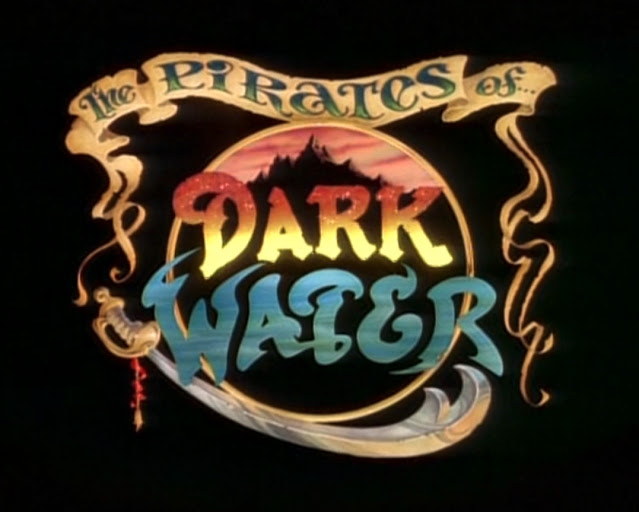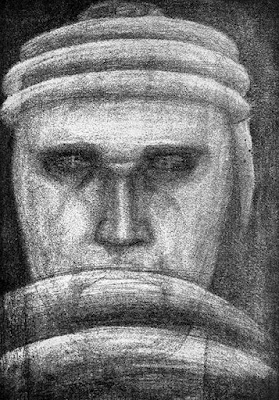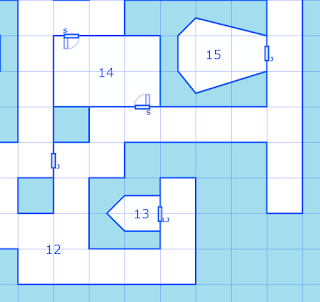|
Chainmail (Because he's using it!) |
Thoughts and Review
Two years ago now - I saw an announcement on X (then Twitter) - that a new solo play for original edition was being broadcast: hosted on YouTube in video. While not an uncommon occurrence - actual plays come and go with some degree of regularity - an uncommon note, one which has since become much more common, was that this new AP was to incorporate Chainmail into its execution! Of course, naturally, I was intrigued.
Solo Dungeon Crawler - our host - introduces himself modestly, if his PayPal tip-jar is to be believed, as Tom Garner from Leeds: a nondescript and inviting informality which aligns well with the atmosphere of a wargaming club - taking time after the "real" gaming is complete to try out this new and different skirmish scale adventure game. After - recognizing his voice - I would find that Tom is also the host of a well-storied Karameikos campaign: one which I had listened to in years past and which, as a solo game, has - in audio format - dozens of episodes spanning several years.
Credibility having been established - I spent the next few months listening live as episodes were released: but only recently had the thought - with 0e and Chainmail again on the wax, to bring attention back to this under-appreciated product.
What I Liked
As a long-standing proponent of Chainmail both as a stand-alone game and as an accouterment to your D&D experience, it made me very interested to see an 0e actual play which utilized the Chainmail game. However - like many clones and 0e-analogs (Wight Box and Delving Deeper v4 (or in print) come to mind) - he does not substitute out Chainmail for the combat resolution system: instead, he injects Chainmail where the text indicates Chainmail should be (such as when a monster is listed as behaving "as in Chainmail") or where a rule in the LBBs is absent (such as rules regarding combat initiative, turn sequence, or when and how to roll morale).
Arguably - unlike my own attempt - this is how 0e was supposed to be played: with, as Tom puts it, the words in the 0e booklets overlaid on top of Chainmail - covering them, supplanting them, in the same way that the changes in Chainmail, itself, regarding Man to Man or Fantasy Combat replace corresponding default rules, as pertaining to mass combat. While I admit to deviating in the sense that I have historically tried to treat the alternative combat system as entirely alternative - leveraging Chainmail instead - the approach mentioned above where 0e is overlaid to replace elements of Chainmail is a better way to introduce people to the original game (three brown books, expressly): it's familiar enough with the d20 and hit points and all that jazz to be comfortable, but foreign enough with universal d6 damage, different hit dice quantities per level, and absent Thief class to appeal on novelty. This is, of course, in addition to his exploration of the rules.
The second point I planned to raise about the Solo Dungeon Crawler OD&D campaign was actually going to be a point of contention on first draft. I consumed this content as it came out - one episode at a time - and as such, I watched this unfold in regular action: the author was learning. He makes mistakes - he makes rulings where rules exist: and while I was watching at the time, I fumed over where his interpretations differed from my own!
But then he adapted.
Then he changed.
And then he came back and played it by the book where before he did not see the words as written.
He even comes back and talks about the "change ability scores" vs "use ability scores" debate over prime requisite! He does not ret-con previous episodes - which empowers the emerging narrative to continue developing, something appropriate for an actual play: half the appeal of which is to serve as entertainment - but does change the way he plays as he gets better at the rules to adhere to them: experiencing the game as it is written and, to the best of his ability, through eyes uncontaminated by other editions of the game. He is not perfect - some mistakes go uncaught and uncorrected: e.g., a character falling into the water, but not rolling for drowning (which is, interestingly, corrected in his second playlist, Castle of the Quest - linked below); the use of dungeon speed, scale, and procedure in the outdoor environment; etc. - but you the viewer, as you watch his adventure unfold, will learn with him: as a lesson from error often sticks more readily than a lesson from success. So I have since changed my opinion on this: where originally this was a "be wary" point - instead, having waited through the duration of the first series, having watched him evolve: this element of the AP, from my point of view, becomes instead a selling point.
As of this writing, I am aware of the following additional OSR content produced by the Solo Dungeon Crawler:
- Tales of Mystara (Solo BECMI Campaign): Video / Audio
- Castle of the Quest (Allegedly solo LBB Campaign, but wrought with procedure and advice): Video
- Solo Dungeon Crawler Podcast (musings & advice): Video / Audio
- Solo Dungeon Crawler Blog (musings & advice): SoloDungeonCrawler.blogspot.com
- Solo Dungeon Crawler X / Twitter
In terms of procedure - in an act absolutely essential to working with the original booklets, sans supplements - he applies procedures and rules in inventive places: rulings, perhaps, but rulings leveraging the rules that the situation calls for. Everyone is familiar with the classic OSR saving throws - "Do I roll for Wands? Or would this be more a Petrification???" - but in a more interesting, inventive example, Tom uses the "does the trap go off" chance-in-six to determine if a given damaged platform gives way. It's not a trap, but it is a hazard - and thus can benefit from the trap rules where no rules exist for a rotting wooden floor. This is a fine trick and a good practice: one which I likewise adopt when the opportunity presents itself.
Lastly, the host takes a great deal of effort to create a retro esthetic. The maps looks like pencil and paper, the audio cracks like an analog recording, and the video has intentional distortions in it akin to aging film. This inspired me in running my own 0e-compatible solo AP, which - despite. being much shorter and in woeful need of a new episode - takes on an analog appeal.
The attention to artistry in the visual presentation of this AP makes me want to play D&D - namely, it makes me want to play it at a table: ideally, my mom's fold-out table in the basement of our old house: or on the family ping-pong table, net removed, of the buddy in the neighborhood up the way who introduced me to D&D in the first place all those years ago when TSR was still king.
Aspects to Note
One thing of which old school editions are undeniably guilty is their unforgiving challenge. The goal is to produce better players: your first character will not be your last - and as you get better at the game, get better at understanding the table, your characters will survive better. However - in this AP - Tom squeezes the orange a bit hard on this note: intentionally making bad (or at least, sub-optimal) decisions that appear to make the game more difficult than it is. For example, in the creation of characters, he assigns their classes prior to seeing what the other characters' ability ranges are: in one instance in particular, a 16 natural Intelligence - eligible for a 10% XP bonus for a Magic User - is wasted: being used to trade for a 12 Strength - offering no bonus whatsoever - on a Halfling Fighter so as to "represent the full diversity of classes"... with a 12 Strength and 13 Intelligence naturally rolled! For those following at home - to assign the former his Halfling Fighter and the latter to his female Magic User would result in a marginally better Halfling (as at least it would have a bonus language) and a markedly better Magic User. He does the exact same thing with a Cleric character - opting for a quite average Cleric (all abilities between 8 and 12) over a stat range which could be eligible easily for an XP bonus - which he acknowledges, saying "But we already have a Cleric, so..." he trades Wisdom 3 for 1 to make a Dwarf with no bonuses!
While the math has been done - and we know that in LBB D&D, the ability scores don't matter remotely as much as they do in future editions - it's frustrating to see this and other, in-game instances of "in-character" sub-optimal decision making artificially inflate the lethality and hazard of the original edition.
Finally - one other element which might concern a potential viewer - the host was actually severely injured (an outside event which he mentions in an explanation for hiatus), which brought his 0e adventure to an unexpected halt. While he does pick it up again in a subsequent attempt, the original characters, the original party, doesn't survive the jump - a new party, a new story begins. This is totally understandable, based on events - but it does also mean that the story doesn't wrap up as cleanly as some of the storylines in other podcasts, other playlists, and other APs that Tom produces.
In Conclusion
The delivery is a bit disjointed - and the playlist is not as long as some of his other work - but Solo Dungeon Crawler's Solo OD&D Campaign is worth your investment. Tom learns as he goes, incorporates house rules where necessary, but by and large, stays within the RAW - making the learning process valuable to someone looking to get into the original edition.
Further, his exposition on why Chainmail is necessary is the most insightful and most comprehensive argument for Chainmail that I have yet seen - one which I have linked otherwheres many times. For that reason - a bit of tongue in cheek appropriateness - I've rated this playlist as Chainmail as well.
Delve on!





































